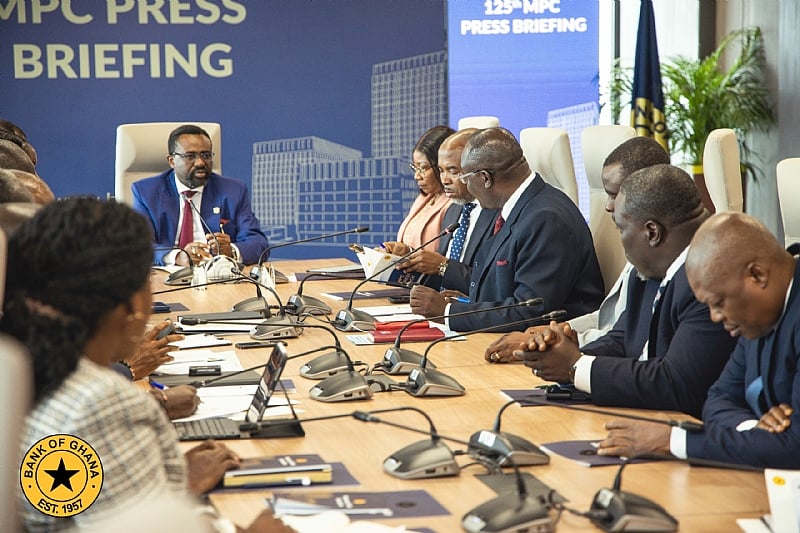Paragraph 1: The Bank of Ghana’s Bold Move and Rationale
The Bank of Ghana (BoG) has implemented a substantial reduction in its Monetary Policy Rate (MPR), cutting it by 300 basis points from 28% to 25%. This significant decrease, announced on July 30, 2025, following the 125th Monetary Policy Committee (MPC) meeting, marks the lowest MPR level in over two years. The BoG’s decision reflects growing confidence in the nation’s economic recovery trajectory and aims to further stimulate economic growth while maintaining price stability. The central bank attributed this decision primarily to a notable improvement in macroeconomic indicators, the robust performance of the Ghanaian cedi, and a discernible easing of inflationary pressures. This move signals a shift in monetary policy stance, indicating a belief that the economy is robust enough to handle lower interest rates without triggering excessive inflation.
Paragraph 2: Declining Inflation and Strengthening Cedi
The BoG’s decision to lower the MPR was heavily influenced by the sharp decline in headline inflation. Inflation fell from 18.4% in May 2025 to 13.7% in June 2025, marking its lowest point since December 2021. Several factors contributed to this positive development, including the tight monetary policy maintained by the BoG in previous periods, improvements in food supply, ongoing fiscal consolidation efforts by the government, and the significant appreciation of the cedi. The cedi experienced impressive gains against major international currencies in 2025, appreciating by 40.7% against the US dollar, 31.2% against the British pound, and 24.2% against the euro. This surge in the cedi’s value can be attributed to increased earnings from gold and cocoa exports, improved remittance inflows, and a healthy current account surplus of US$3.4 billion recorded in the first half of 2025.
Paragraph 3: Positive Economic Growth and Improved Reserves
Further bolstering the BoG’s confidence were the positive signs of economic growth observed in the first quarter of 2025. Real GDP growth reached 5.3%, with the non-oil sector demonstrating even stronger growth at 6.8%. These growth figures indicate a healthy and diversifying economy. This positive economic performance was accompanied by a rise in both business and consumer confidence, suggesting a positive outlook for future economic activity. In addition, core inflation indicators also showed declines across the board. Ghana’s gross international reserves also saw significant improvement, reaching US$11.1 billion, equivalent to 4.8 months of import cover. This robust reserve position provides a buffer against external shocks and supports the stability of the cedi.
Paragraph 4: Fiscal Consolidation and Debt Reduction
The government’s commitment to fiscal consolidation played a crucial role in creating a favorable macroeconomic environment for the MPR reduction. Budget execution data revealed a fiscal deficit of just 0.7% of GDP, significantly lower than the targeted 1.8%. This fiscal discipline contributed to a substantial reduction in the country’s total public debt, which decreased from 61.8% of GDP in December 2024 to 43.8% in June 2025. The cedi’s appreciation, reduced borrowing, and successful external debt restructuring all contributed to this positive development in public debt management. This fiscal prudence creates space for greater investment in critical sectors and strengthens the overall economic foundation.
Paragraph 5: Acknowledging Risks and Maintaining Vigilance
Despite the overall positive outlook, the MPC acknowledges potential risks that could impact the Ghanaian economy. These include global trade tensions, potential increases in utility tariffs, and ongoing supply chain challenges. These external and internal factors could disrupt the current positive trajectory. However, the BoG expressed confidence that its continued commitment to tight monetary policy and the government’s ongoing fiscal discipline would effectively mitigate these potential risks. This proactive approach seeks to ensure that the economy remains resilient in the face of potential challenges.
Paragraph 6: Future Policy Direction and Commitment to Stability
The BoG indicated a willingness to further reduce the policy rate in the coming months, contingent on the continuation of the disinflationary trend. This forward guidance provides clarity to the market and signals the central bank’s commitment to supporting economic growth. The MPC emphasized its unwavering dedication to maintaining price stability while fostering inclusive and sustainable economic growth. The central bank will continue to monitor economic developments closely and adjust its policy stance as needed to achieve its mandates. The next MPC meeting, scheduled for September 15–17, 2025, will provide an opportunity to further assess the economic situation and make any necessary policy adjustments. This ongoing monitoring and evaluation will ensure that monetary policy remains appropriately calibrated to support the nation’s economic objectives.


